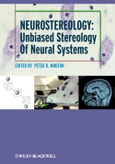Stereological methods provide researchers with unparalleled quantitative data from tissue samples and allow for well-evidenced research advances in a broad range of scientific fields. Presenting a concise introduction to the methodology and application of stereological research in neuroscience, Neurostereology provides a fuller understanding of the use of these methods in research and a means for replicating successful scientific approaches. Providing sound footing for future research, Neurostereology is a useful tool for basic and clinical researchers and advanced students looking to integrate these methods into their research.
Table of Contents
Contributors ix
Preface xiii
1 Stereological Estimation of Brain Volume and Surface Area from MR Images 3
Niyazi Acer and Mehmet Turgut
Background 3
The Cavalieri Principle 3
Volume Estimation Using Spatial Grid of Points 7
Surface Area Estimation 8
Isotropic Cavalieri Design 14
Sections Analyzed with Independent Grid Design 14
Surface Area Using the Invariator 16
Volume and Surface Area Estimation Using Segmentation Method 17
Discussion 18
References 19
Webliography 21
Appendix A: R Commands for Point Counting Method 21
Appendix B: R Commands for Vertical Section to Estimate Surface Area 23
2 Cell Proliferation in the Brains of Adult Rats Exposed to Traumatic Brain Injury 27
Sandra A. Acosta, Naoki Tajiri, Paula C. Bickford, and Cesar V. Borlongan
Background 27
Materials and Methods 28
Results 29
Discussion 33
Acknowledgments 37
References 37
3 Age Effects in Substantia Nigra of Asian Indians 39
Phalguni Anand Alladi
Background 39
Materials and Methods 40
Discussion 43
Acknowledgments 48
References 49
4 Design-Based Stereology in the Brain Bank Setting 53
Mark W. Burke
Background 53
Specimen Preparation 53
A Practical Application of Design-Based Stereology 57
Results 59
Conclusion 60
References 61
5 Practical Stereology for Preclinical Neurotoxicology 63
Mark T. Butt
Background 63
Specimen Quality 64
Practical Stereology 70
Software Validation/Verifi cation 70
References 72
6 An Overabundance of Prefrontal Cortex Neurons Underlies Early Brain Overgrowth in Autism 73
Eric Courchesne, Peter R. Mouton, Michael E. Calhoun, Clelia Ahrens-Barbeau, Melodie J. Hallet, Cynthia Carter Barnes, Karen Pierce, and Katarina Semendeferi
Background 73
Methods 74
Results 78
Discussion 80
Acknowledgments 81
References 82
7 Order in Chaos: Stereological Studies of Nervous Tissue 85
Peter Dockery
Background 85
The Stereological Approach 85
Axonal Number and Composition in the Murine Optic Nerve 91
Axonal and Fiber Size Distributions 92
The Myelin Sheath 93
Conclusion 94
References 95
8 Comparative Stereology Studies of Brains from Marine Mammals 99
Nina Eriksen and Bente Pakkenberg
Background 99
Description of Different Marine Mammalian Brains 99
Parts of the Brain 102
References 109
Appendix: Cited Stereological Approaches 110
9 Quantitative Assessment of Hippocampus Architecture Using the Optical Disector 113
Shozo Jinno
Background 113
The Hippocampus 114
Conclusion 123
References 123
10 The Possible Applications (and Pitfalls!) of Stereological Analysis in Postmortem Brain Research 129
Ahmad A. Khundakar and Alan J. Thomas
Background 129
The Legacy of Two-Dimensional (2D) Analysis 129
Density: A Necessary Evil 130
“Come on, Feel the Noise”: Recognizing Confounding Factors 130
“I Am Not a Number”: The Importance of Sound Patient Clinical History 131
Lessons Learned from Stereology: Toward a More Unifi ed Approach to Brain Banking and Postmortem Tissue Research (and Beyond!) 132
Obtain the Full Reference Volume or “Make Do and Mend” 133
Turn Down the “Noise” 134
“Check the Information, Expand the Knowledge” 135
Show Your Work! 135
Conclusion 136
Acknowledgments 136
References 136
11 Visualization of Blood Vessels in Two-Dimensional and Three-Dimensional Environments for Vascular Stereology in the Brain 139
Zerina Lokmic
Background 139
Vascular Stereology of Tissue Sections 139
Visualization of Brain Blood Vessels 142
Conclusion 149
Acknowledgment 149
References 149
12 Blood Flow Analysis in Epilepsy Using a Novel Stereological Approach 153
Rocio Leal-Campanario, Luis Alarcon-Martinez, Susana Martinez-Conde, Michael Calhoun, and Stephen Macknik
Background 153
Materials and Methods 155
Results 166
Discussion 172
References 173
13 AD-Type Neuron Loss in Transgenic Mouse Models 177
Kebreten F. Manaye and Peter R. Mouton
Background 177
Materials and Methods 179
Results 182
Discussion 185
Acknowledgments 187
References 188
14 Quantification in Populations of Nonuniformly Distributed Cells in the Human Cerebral Cortex 191
William L. Maxwell
Background 191
Materials and Methods 191
Results 196
Discussion 205
References 208
15 The Effects of High-Fat Diet on the Mouse Hypothalamus: A Stereological Study 211
Mohammad Reza Namavar, Samira Raminfard, Zahra Vojdani Jahromi, and Hassan Azari
Background 211
Materials and Methods 212
Results 213
Discussion 215
Acknowledgments 217
References 218
16 2D and 3D Morphometric Analyses Comparing Three Rodent Models 221
JiHyuk Park and S. Omar Ahmad
Background 221
Materials and Methods 221
Results 226
Discussion 230
References 235
17 A Stereologic Perspective on Autism Neuropathology 237
Neha Uppal and Patrick R. Hof
Background 237
Cortical Areas 237
Hippocampus 248
Noncortical Areas 249
Conclusions 253
References 254
Index 257








